|
|
|
|
|
Back to the main menu of species Clymene Dolphin 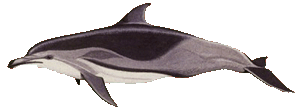
Scientific Name: Stenella clymene Other Names: Short Snouted Spinner Dolphin Length: 5.8-6.5 ft. (1.7-2 m.) Weight: 110-200 lbs. (50-90 kg.) Teeth: 152-194 Once considered one of the many variations
of long-snouted spinner dolphins, the clymene was officially classified as a seperate
species in 1981. The ranges of two species overlap in the Atlantic and are difficult
to tell apart. The clymene is slightly more robust, the dorsal fin is less triangular,
and the beak is a little shorter. These dolphins are believed to be nocturnal feeders.
Commerson's Dolphin 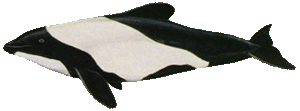
Scientific Name: Cephalorhynchus commersonii Other Names: Piebald Dolphin, Skunk Dolphin, Jacobite Length: 4.3-5.8 ft. (1.3-1.7 m.) Weight: 75-130 lbs. (35-60 kg.) Teeth: 106-140 The commerson's dolphin is actually very similar to a porpoise. They inhabit the waters of the southern hemisphere. Paddle like flippers, short rounded dorsal fins, and wide flukes are all characteristics of commerson's dolphins. Calves are born all gray, black, and brown, however, they develop adult markings as they mature. Male and female dolphins have different black patches on their
undersides. The patches of males are shaped like raindrops and the patches on
females are shaped like horseshoes.
Common Dolphin 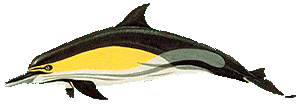
Scientific Name: Delphinus capensis Other Names: Saddleback dolphin, Criss-cross dolphin, Cape dolphin Length: 5.8-8 ft. (1.7-2.4 m.) Weight: 155-245 lbs. (70-110 kg.) Teeth: 160-240 Common dolphins vary greatly in appearance. One of the features of common dolphins include a dark band around their eyes extending to the end of their long narrow beaks. common dolphins also have black backs, white undersides, and prominent gray and yellowish-brown stripes on their sides resembling an elaborate criss-cross or hourglass pattern. There are two major varieties of common dolphins called
the short beaked common dolphin and the long beaked common dolphin.
The body of the short beaked common dolphin is slightly more robust and the
head is more rounded. There are also differences in behaviors and feeding
patterns.
Dusky Dolphin 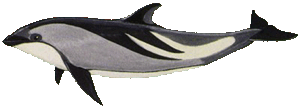
Scientific Name: Lagenorhynchus obscurus Other Names: Fitzroy's Dolphin Length: 5.3-7 ft. (1.6-2.1 m.) Weight: 110-200 lbs. (50-90 kg.) Teeth: 94-144 Dusky dolphins are some of the most acrobatic of all dolphins. They are well known for their extraordinarily high leaps and somersaults. Dusky dolphins are often seen with seabirds and frequently associate with other cetaceans. These dolphins are easily approached and seem to enjoy contact with boats and humans. The three main types of breaching performed by dusky dolphins are arc shaped leaps, lobtailing, and high somersaults and twists. The Dusky dolphin is extremely similar to the Pacific white-sided dolphin. Some experts have
even suggested that they belong to the same species.
False Killer Whale 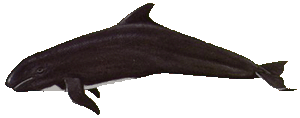
Scientific Name: Pseudorca crassidens Other Names: False Pilot Whale Length: 14-19.8 ft. (4.3-6 m.) Weight: 1.1-2.2 tons Teeth: 32-44 Unlike the killer whale, their flippers
are slim pointed rather than blunt. They prefer the deep water of the ocean
where it makes meals of squid and fish. False killer whales are exceptionally
active and playful. They may make sudden stops or turns and approach boats
to investigate, bow-ride, and wake-ride.
Fraser's Dolphin 
Scientific Name: Lagenodelphis hosei Other Names: Sarawak Dolphin, Bornean Dolphin Length: 6.5-8.5 ft. (2-2.6 m.) Weight: approx. 350-460 lbs. (160-210 kg.) Teeth: 140-176 The species of fraser's dolphin was
originally found on a Western Bornio beach in 1895. The species was not
seen alive until the early 1970's. still, very little is known about this dolphin.
They are very wary of ships and swim rapidly away when approached, which
might account for their relative obscurity.
Please dont forget to sign my guestbook as I love getting mail.Sign my Dreambook! |